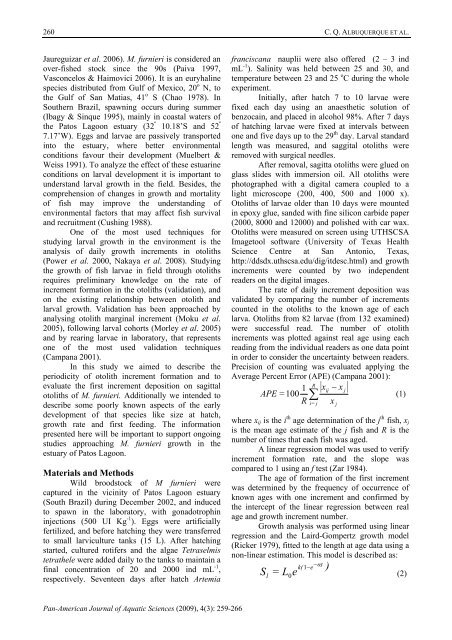Download full issue - PanamJAS
Download full issue - PanamJAS
Download full issue - PanamJAS
Create successful ePaper yourself
Turn your PDF publications into a flip-book with our unique Google optimized e-Paper software.
260<br />
C. Q. ALBUQUERQUE ET AL.<br />
Jaureguizar et al. 2006). M. furnieri is considered an<br />
over-fished stock since the 90s (Paiva 1997,<br />
Vasconcelos & Haimovici 2006). It is an euryhaline<br />
species distributed from Gulf of Mexico, 20 o N, to<br />
the Gulf of San Matias, 41 o S (Chao 1978). In<br />
Southern Brazil, spawning occurs during summer<br />
(Ibagy & Sinque 1995), mainly in coastal waters of<br />
the Patos Lagoon estuary (32 º 10.18’S and 52 º<br />
7.17’W). Eggs and larvae are passively transported<br />
into the estuary, where better environmental<br />
conditions favour their development (Muelbert &<br />
Weiss 1991). To analyze the effect of these estuarine<br />
conditions on larval development it is important to<br />
understand larval growth in the field. Besides, the<br />
comprehension of changes in growth and mortality<br />
of fish may improve the understanding of<br />
environmental factors that may affect fish survival<br />
and recruitment (Cushing 1988).<br />
One of the most used techniques for<br />
studying larval growth in the environment is the<br />
analysis of daily growth increments in otoliths<br />
(Power et al. 2000, Nakaya et al. 2008). Studying<br />
the growth of fish larvae in field through otoliths<br />
requires preliminary knowledge on the rate of<br />
increment formation in the otoliths (validation), and<br />
on the existing relationship between otolith and<br />
larval growth. Validation has been approached by<br />
analysing otolith marginal increment (Moku et al.<br />
2005), following larval cohorts (Morley et al. 2005)<br />
and by rearing larvae in laboratory, that represents<br />
one of the most used validation techniques<br />
(Campana 2001).<br />
In this study we aimed to describe the<br />
periodicity of otolith increment formation and to<br />
evaluate the first increment deposition on sagittal<br />
otoliths of M. furnieri. Additionally we intended to<br />
describe some poorly known aspects of the early<br />
development of that species like size at hatch,<br />
growth rate and first feeding. The information<br />
presented here will be important to support ongoing<br />
studies approaching M. furnieri growth in the<br />
estuary of Patos Lagoon.<br />
Materials and Methods<br />
Wild broodstock of M furnieri were<br />
captured in the vicinity of Patos Lagoon estuary<br />
(South Brazil) during December 2002, and induced<br />
to spawn in the laboratory, with gonadotrophin<br />
injections (500 UI Kg -1 ). Eggs were artificially<br />
fertilized, and before hatching they were transferred<br />
to small larviculture tanks (15 L). After hatching<br />
started, cultured rotifers and the algae Tetraselmis<br />
tetrathele were added daily to the tanks to maintain a<br />
final concentration of 20 and 2000 ind mL -1 ,<br />
respectively. Seventeen days after hatch Artemia<br />
franciscana nauplii were also offered (2 – 3 ind<br />
mL -1 ). Salinity was held between 25 and 30, and<br />
temperature between 23 and 25 o C during the whole<br />
experiment.<br />
Initially, after hatch 7 to 10 larvae were<br />
fixed each day using an anaesthetic solution of<br />
benzocain, and placed in alcohol 98%. After 7 days<br />
of hatching larvae were fixed at intervals between<br />
one and five days up to the 29 th day. Larval standard<br />
length was measured, and saggital otoliths were<br />
removed with surgical needles.<br />
After removal, sagitta otoliths were glued on<br />
glass slides with immersion oil. All otoliths were<br />
photographed with a digital camera coupled to a<br />
light microscope (200, 400, 500 and 1000 x).<br />
Otoliths of larvae older than 10 days were mounted<br />
in epoxy glue, sanded with fine silicon carbide paper<br />
(2000, 8000 and 12000) and polished with car wax.<br />
Otoliths were measured on screen using UTHSCSA<br />
Imagetool software (University of Texas Health<br />
Science Centre at San Antonio, Texas,<br />
http://ddsdx.uthscsa.edu/dig/itdesc.html) and growth<br />
increments were counted by two independent<br />
readers on the digital images.<br />
The rate of daily increment deposition was<br />
validated by comparing the number of increments<br />
counted in the otoliths to the known age of each<br />
larva. Otoliths from 82 larvae (from 132 examined)<br />
were successful read. The number of otolith<br />
increments was plotted against real age using each<br />
reading from the individual readers as one data point<br />
in order to consider the uncertainty between readers.<br />
Precision of counting was evaluated applying the<br />
Average Percent Error (APE) (Campana 2001):<br />
R<br />
1 | x |<br />
∑<br />
− ij<br />
x<br />
j<br />
APE = 100 (1)<br />
R x<br />
i= j<br />
where x ij is the i th age determination of the j th fish, x j<br />
is the mean age estimate of the j fish and R is the<br />
number of times that each fish was aged.<br />
A linear regression model was used to verify<br />
increment formation rate, and the slope was<br />
compared to 1 using an f test (Zar 1984).<br />
The age of formation of the first increment<br />
was determined by the frequency of occurrence of<br />
known ages with one increment and confirmed by<br />
the intercept of the linear regression between real<br />
age and growth increment number.<br />
Growth analysis was performed using linear<br />
regression and the Laird-Gompertz growth model<br />
(Ricker 1979), fitted to the length at age data using a<br />
non-linear estimation. This model is described as:<br />
S<br />
l<br />
= L<br />
e<br />
k( 1−e<br />
−αt<br />
)<br />
j<br />
0 (2)<br />
Pan-American Journal of Aquatic Sciences (2009), 4(3): 259-266
















